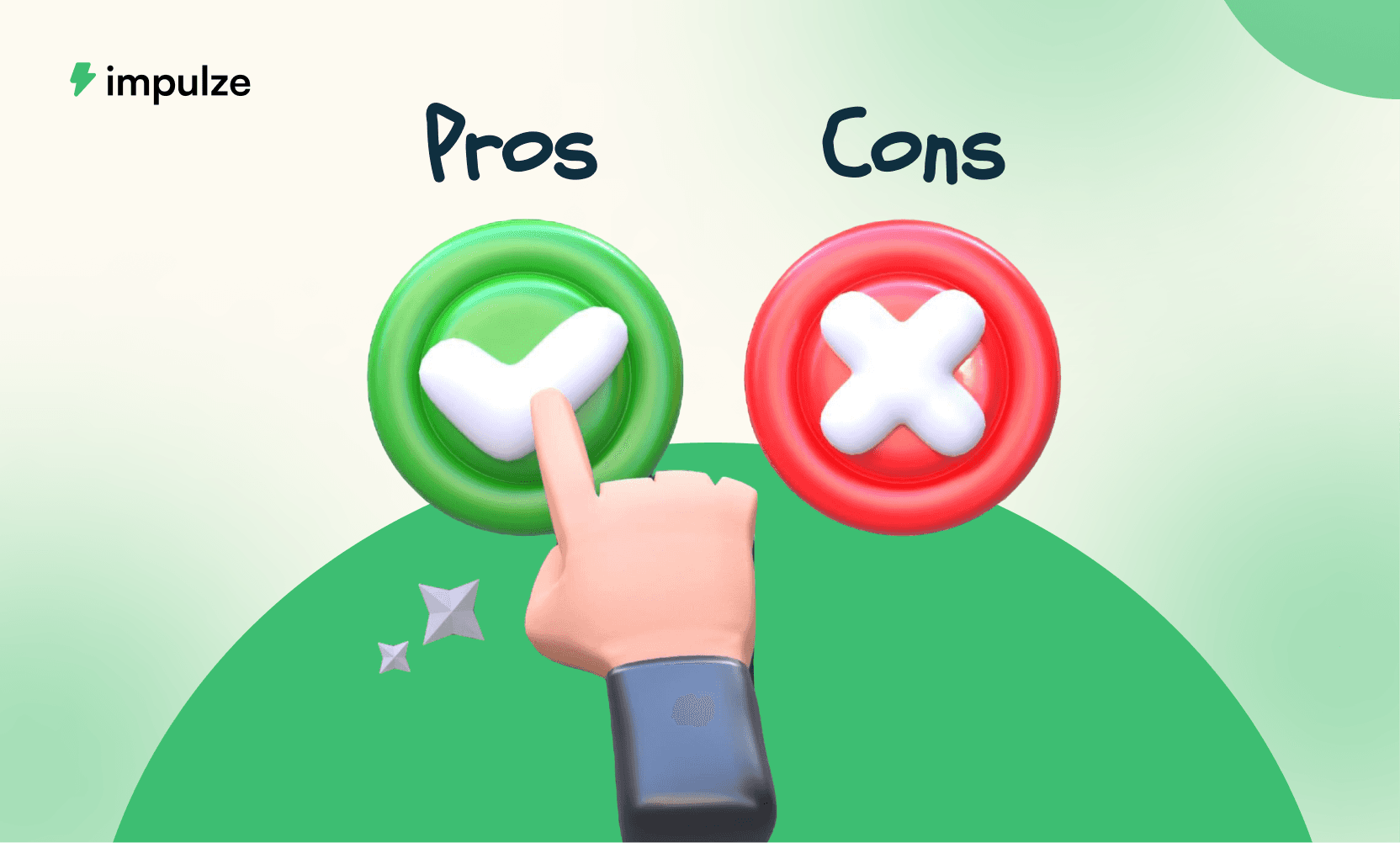2025/01/13
10 MIN READ
INFLUENCER MARKETING
INFLUENCER MARKETING
5 Best Ways To Find YouTube Influencers + Free Tools To Find Them
5 Best Ways To Find YouTube Influencers + Free Tools To Find Them
5 Best Ways To Find YouTube Influencers + Free Tools To Find Them

Aishwarya Taskar
Aishwarya Taskar
Aishwarya Taskar
Aishwarya Taskar
Content Marketer @impulze.ai




Sections
Blog in Short ⏱️
Blog in Short ⏱️
A quick glance at the highlights—perfect for when you're short on time.
A quick glance at the highlights—perfect for when you're short on time.
Want to find YouTube influencers? Here are the best ways to find the perfect match for your brand:
Use Free Tools: Platforms like impulze.ai allow you to filter by location, engagement, and more to find the right influencers.
Work with Agencies: Influencer agencies offer expertise and time-saving but come at a higher cost.
Find Lookalike Influencers: Use tools like SocialiQ to discover influencers similar to the ones you admire.
YouTube Search: Leverage keyword searches, trending content, and hashtags to find relevant creators.
Google Search: A simple way to find top influencers, but it requires more research.
Influencer marketing tools like impulze.ai can help you handpick influencers that match your brand’s audience.
YouTube was projected to capture $986 million of U.S. influencer marketing expenditure in 2024, ranking second after Instagram. YouTube has become a trusted space for brands to connect with audiences.
If you’re one of the brands looking to find YouTube influencers and use this powerful platform, this blog can help you. Finding the right influencers is key for those looking to make the most of this platform. In this blog, we'll discuss two free tools you can use to find YouTube content creators and other ways you can do this.
Let’s dig into the details.
5 Smart Ways To Find YouTube Influencers for Your Brand
1. Use Free Tools to Find YouTube Influencers
Using influencer marketing tools is one of the best ways to find YouTube influencers because you can use filters like location, engagement rate, follower size, etc.
impulze.ai offers a free 14-day trial that you can use to find Youtube influencers. Suppose you want to find YouTube influencers for home decor in the US.
Sign up and follow these steps to find them:
Step 1: Click on ‘Search’ at the top of the screen. (See screenshot below)
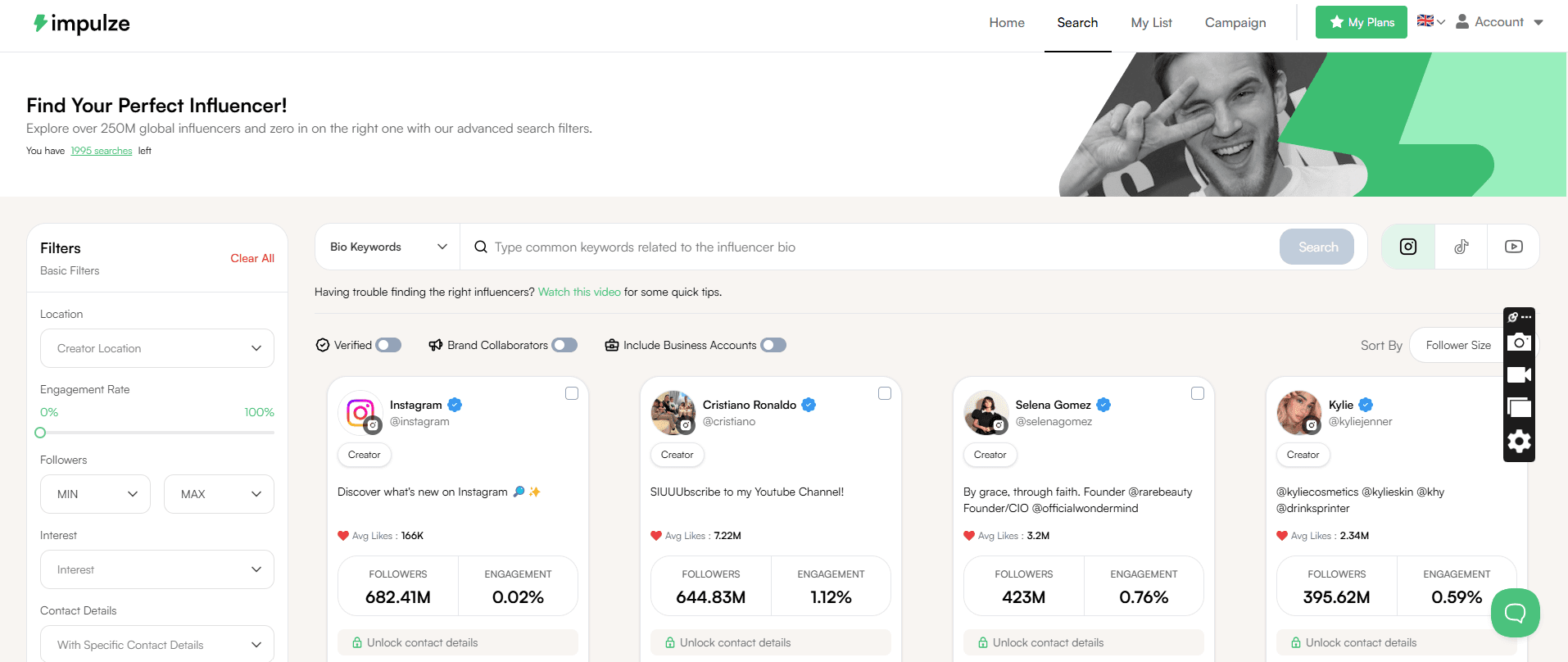
Step 2: Choose YouTube on the left, next to the Search button. Choose the location in the filters bar on the left. Then, choose bio keywords from the drop-down on the left. Type ‘Home decor’ in the search bar and click ‘Search.’
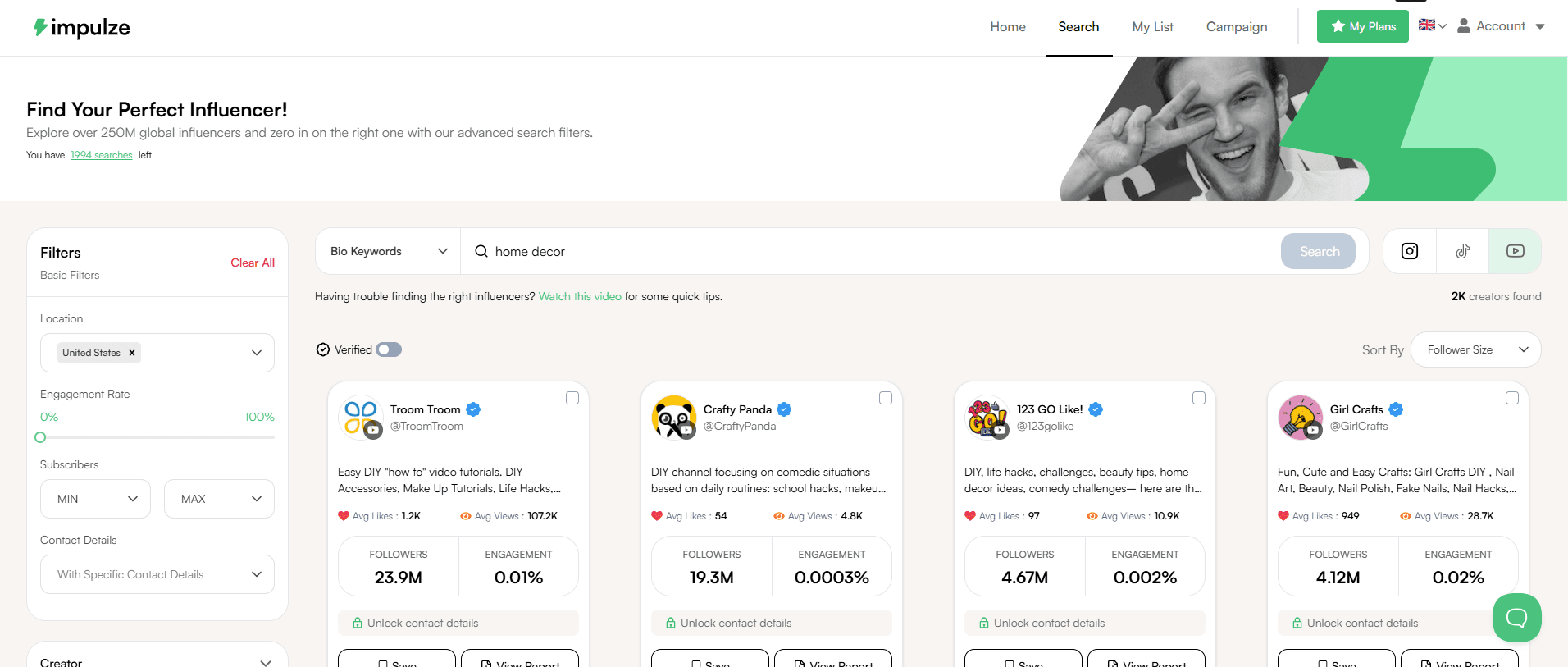
Step 3: You can choose any option from the drop-down on the left. So, if you want to find YouTube influencers who have used ‘Home decor’ in their posts’ captions, you can choose ‘Post description’ on the left, type home decor and click ‘Search’.
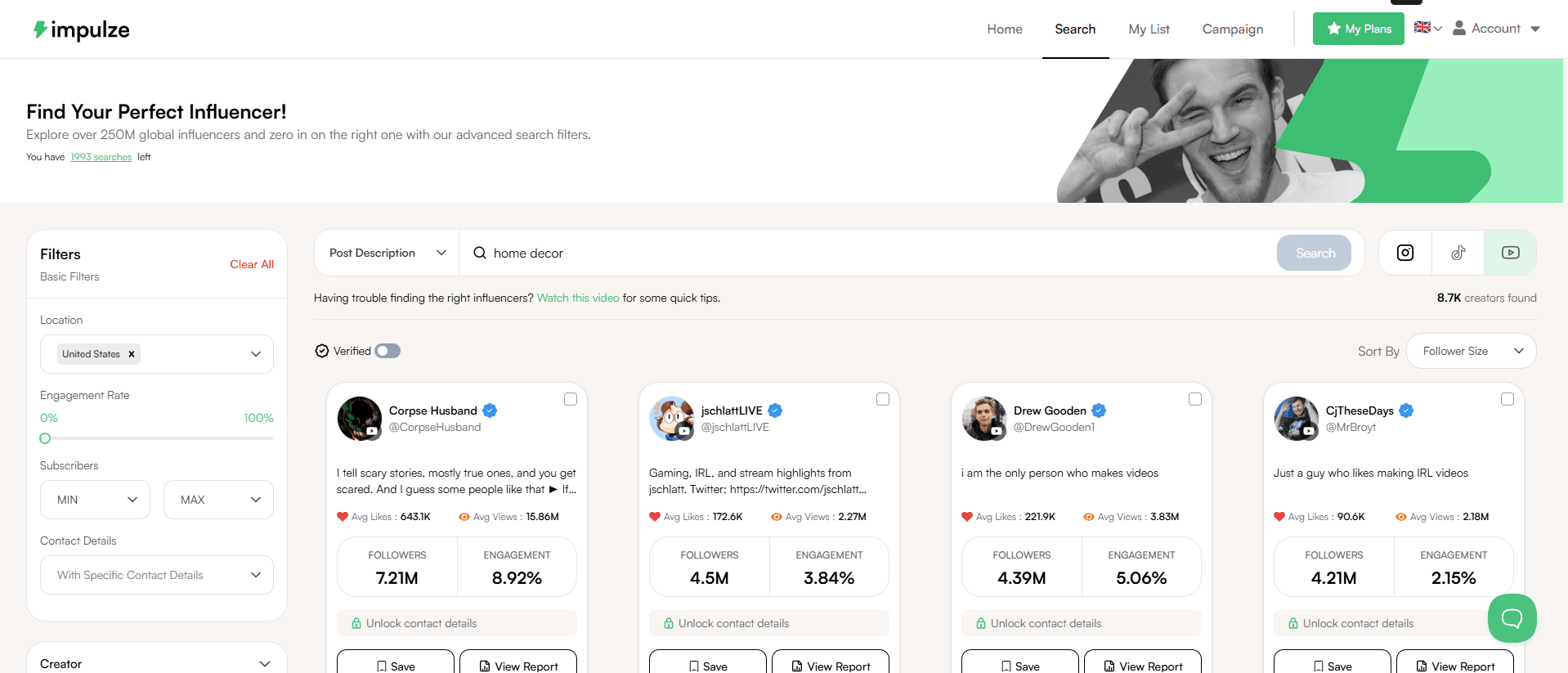
You can also choose filters like engagement rate, subscribers, contact details, etc., to find YouTube influencers that match what you have in mind.
One of the other advantages of using tools like impulze.ai to find YouTube influencers is that it would make influencer outreach easy for you. Click on the ‘Contact’ icon under any influencer’s name and if the influencer’s email is a part of your database, it will show the influencer’s phone number and/or email address there.
You can also use SocialiQ, our Chrome extension, to find influencers right on social media. Once you have SocialiQ installed, open YouTube, type ‘[Home decor]’ in its search bar, and choose the location. Click ‘Search,’ and the extension will show you YouTube influencers who have mentioned ‘home decor’ in their YouTube account’s description/bio.
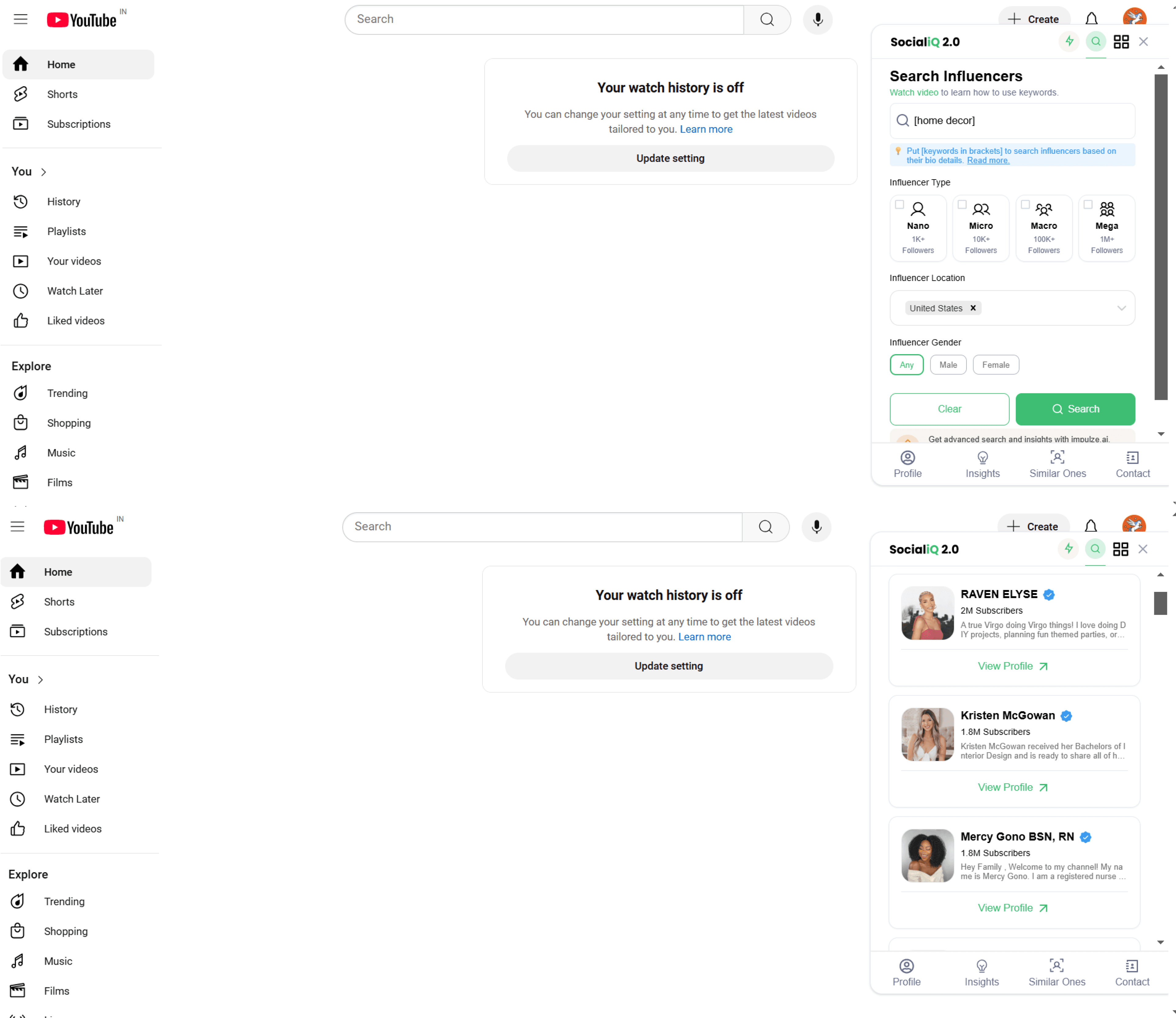
Here’s an important thing you should know about using SocialiQ: When you use SocialiQ’s search feature to find influencers, the search results heavily depend on how you enter keywords. Use this guide to learn how to use words in SocialiQ’s search feature.
2. Work With an Influencer Marketing Agency
You can also work with an influencer marketing agency to find YouTube influencers. Look for an agency that suits your needs, and they’ll take care of everything.
However, working with an influencer marketing agency would cost more and isn’t viable for small businesses that want to implement influencer marketing ideas.
Let’s look at the pros and cons of using this way to find YouTube influencers.
Pros of Working with an Influencer Marketing Agency
Expertise: Agencies have experience and can find the right YouTube influencers for your brand.
Time-saving: They handle the research, outreach, and negotiation, saving you time.
Access to top influencers: Agencies often have connections with high-profile influencers you may not find on your own.
Cons of Working with an Influencer Marketing Agency
Higher cost: Agencies charge a considerable fee for their services, which might be too expensive for small businesses.
Less control: You may have less direct control over the selection and management of influencers.
One-size-fits-all approach: Agencies may apply generic strategies that don’t align with your unique needs.
While agencies offer many benefits, small businesses that have a tight budget may not be able to work with them. Such companies can use free influencer marketing tools for budget-friendly campaigns or use any of the other methods listed below.
3. Search for Lookalike Influencers
Consider this: You found Linda, an American home decor YouTube influencer, and you like her content. You want to find YouTube influencers similar to her. SocialiQ can help you do this in seconds.
You can find lookalike influencers using SocialiQ’s ‘Similar Ones’ feature. To do this, open Linda’s YouTube channel (LG Queen Home Decor). Click on ‘Similar Ones’ at the bottom in SocialiQ. Now click on ‘Unlock Now,’ and SocialiQ will show you influencers who have posted similar content to Linda’s.
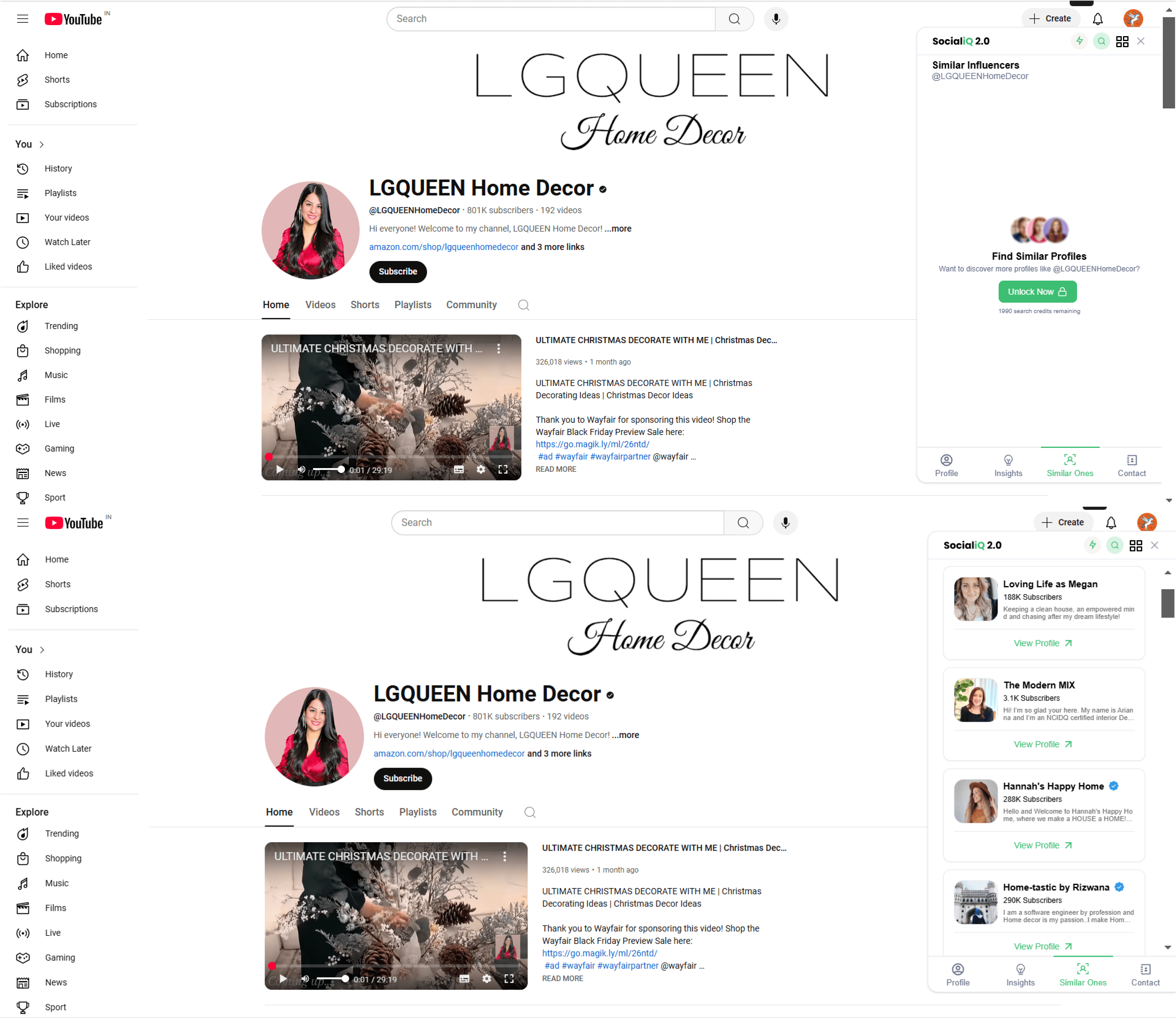
4. YouTube Search
You can also use YouTube’s search bar to find influencers.
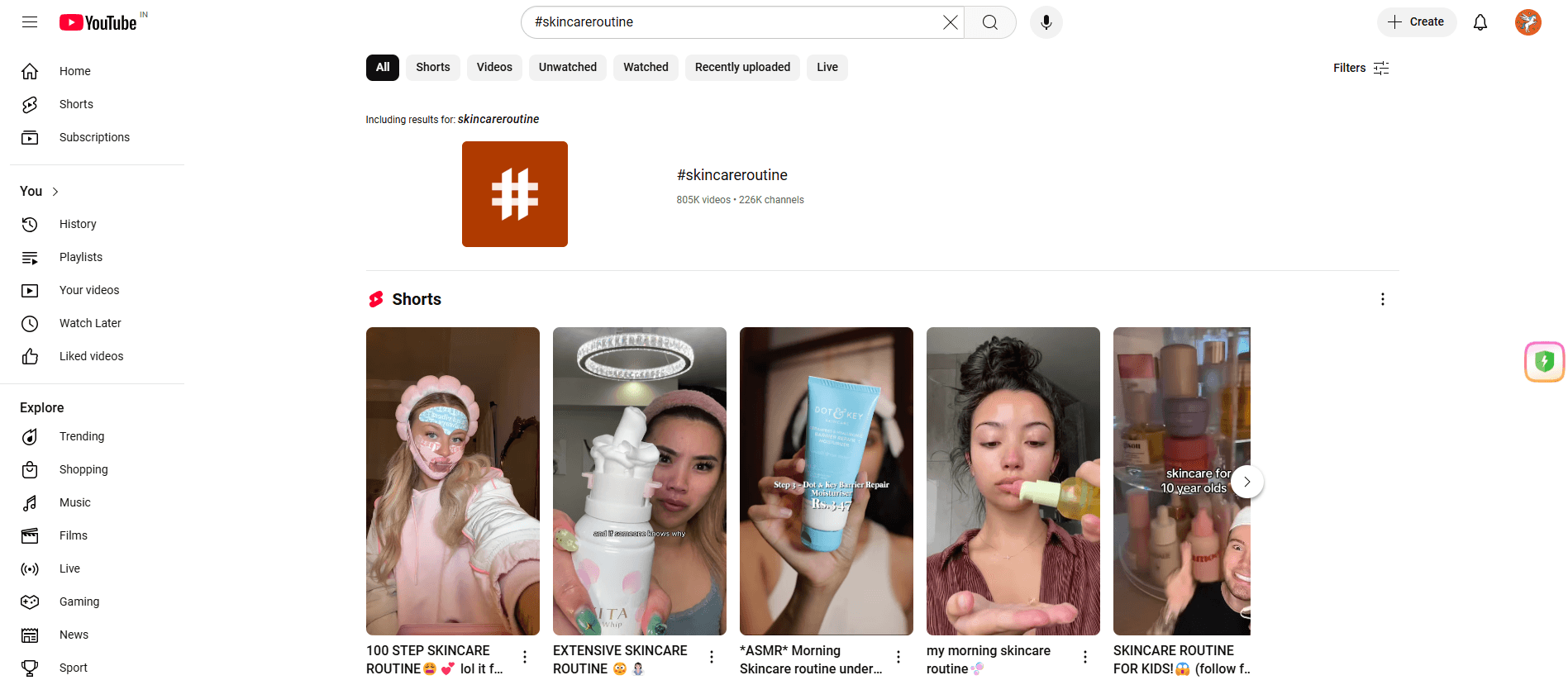
Here’s how to use YouTube search to find influencers:
Start with Keyword Searches
For instance, if you're in the beauty industry, you might search for ‘organic makeup tutorials’ or ‘skincare routines for acne.’ Pay attention to creators who appear frequently in search results with content that matches your brand's values and audience interests. These creators likely have a dedicated following and are interested in these specific topics.Look into the Trending Tab
The Trending tab on YouTube is a useful resource for discovering content that is currently popular. This feature can be particularly helpful for identifying rising stars in various niches. While the content here is broader and not always niche-specific, it can provide insights into current trends and micro-influencers gaining traction with larger audiences.Do Hashtag Searches
Hashtag searches can be incredibly valuable for finding content around specific themes or topics. For example, searching for hashtags like #EcoFriendlyLiving or #TechReviews can lead you to micro-influencers who specialize in these areas.
This method gives you a firsthand look at the type of content produced and how audiences respond to it. However, this is a time-consuming way to find YouTube influencers. If you’re short on time, you can consider using the next method on this list.
5. Google Search
A simple Google search with the right keywords can do wonders. For instance, you can search for top gaming YouTube influencers. Google will show you lists of the top gaming influencers. You can pick influencers from here, scrutinize their content, and see which influencer would fit your brand.
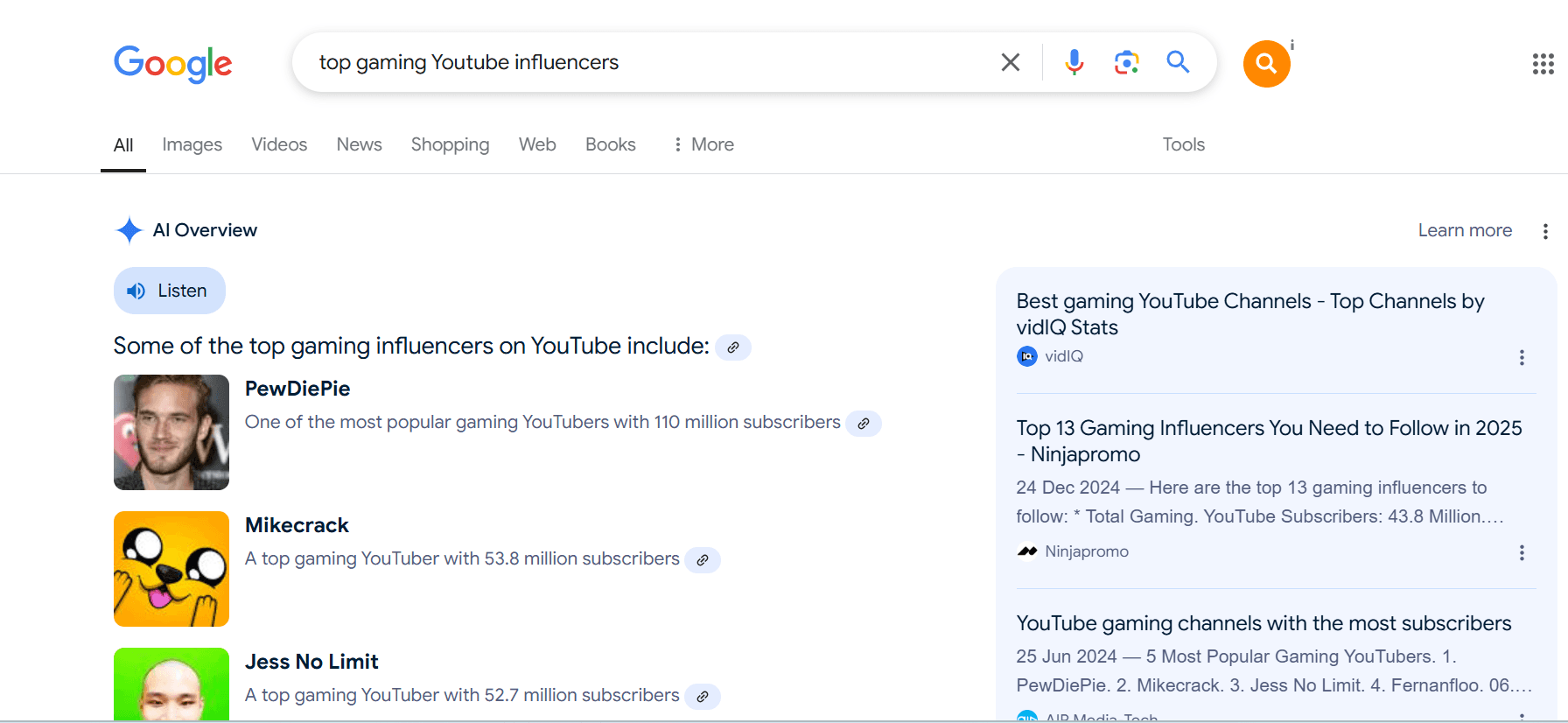
This method can provide you with names of influencers quickly, but you’d still have to analyze the influencer’s followers and content and see if they would fit your brand well. If you’re looking for micro-influencers who can work with a small business, it would be better to use an influencer marketing tool to find micro-influencers based on location that would be a good fit for your business.
Which is the Best Way to Find YouTube Influencers?
Each method has its pros and cons. What’s best for you will depend on your needs and situation. Take a look at the infographic below, which lists the pros and cons of each method and which method is best for whom.

The Takeaway
Each method discussed in this blog offers unique advantages, empowering you to find YouTube influencers that align with your goals and budget.
You can choose a way that suits your needs and budget. If you want to use influencer marketing tools, try impulze.ai and see if it suits your needs. Use our 14-day free trial and find YouTube influencers that match your target audience in minutes!

YouTube was projected to capture $986 million of U.S. influencer marketing expenditure in 2024, ranking second after Instagram. YouTube has become a trusted space for brands to connect with audiences.
If you’re one of the brands looking to find YouTube influencers and use this powerful platform, this blog can help you. Finding the right influencers is key for those looking to make the most of this platform. In this blog, we'll discuss two free tools you can use to find YouTube content creators and other ways you can do this.
Let’s dig into the details.
5 Smart Ways To Find YouTube Influencers for Your Brand
1. Use Free Tools to Find YouTube Influencers
Using influencer marketing tools is one of the best ways to find YouTube influencers because you can use filters like location, engagement rate, follower size, etc.
impulze.ai offers a free 14-day trial that you can use to find Youtube influencers. Suppose you want to find YouTube influencers for home decor in the US.
Sign up and follow these steps to find them:
Step 1: Click on ‘Search’ at the top of the screen. (See screenshot below)

Step 2: Choose YouTube on the left, next to the Search button. Choose the location in the filters bar on the left. Then, choose bio keywords from the drop-down on the left. Type ‘Home decor’ in the search bar and click ‘Search.’

Step 3: You can choose any option from the drop-down on the left. So, if you want to find YouTube influencers who have used ‘Home decor’ in their posts’ captions, you can choose ‘Post description’ on the left, type home decor and click ‘Search’.

You can also choose filters like engagement rate, subscribers, contact details, etc., to find YouTube influencers that match what you have in mind.
One of the other advantages of using tools like impulze.ai to find YouTube influencers is that it would make influencer outreach easy for you. Click on the ‘Contact’ icon under any influencer’s name and if the influencer’s email is a part of your database, it will show the influencer’s phone number and/or email address there.
You can also use SocialiQ, our Chrome extension, to find influencers right on social media. Once you have SocialiQ installed, open YouTube, type ‘[Home decor]’ in its search bar, and choose the location. Click ‘Search,’ and the extension will show you YouTube influencers who have mentioned ‘home decor’ in their YouTube account’s description/bio.

Here’s an important thing you should know about using SocialiQ: When you use SocialiQ’s search feature to find influencers, the search results heavily depend on how you enter keywords. Use this guide to learn how to use words in SocialiQ’s search feature.
2. Work With an Influencer Marketing Agency
You can also work with an influencer marketing agency to find YouTube influencers. Look for an agency that suits your needs, and they’ll take care of everything.
However, working with an influencer marketing agency would cost more and isn’t viable for small businesses that want to implement influencer marketing ideas.
Let’s look at the pros and cons of using this way to find YouTube influencers.
Pros of Working with an Influencer Marketing Agency
Expertise: Agencies have experience and can find the right YouTube influencers for your brand.
Time-saving: They handle the research, outreach, and negotiation, saving you time.
Access to top influencers: Agencies often have connections with high-profile influencers you may not find on your own.
Cons of Working with an Influencer Marketing Agency
Higher cost: Agencies charge a considerable fee for their services, which might be too expensive for small businesses.
Less control: You may have less direct control over the selection and management of influencers.
One-size-fits-all approach: Agencies may apply generic strategies that don’t align with your unique needs.
While agencies offer many benefits, small businesses that have a tight budget may not be able to work with them. Such companies can use free influencer marketing tools for budget-friendly campaigns or use any of the other methods listed below.
3. Search for Lookalike Influencers
Consider this: You found Linda, an American home decor YouTube influencer, and you like her content. You want to find YouTube influencers similar to her. SocialiQ can help you do this in seconds.
You can find lookalike influencers using SocialiQ’s ‘Similar Ones’ feature. To do this, open Linda’s YouTube channel (LG Queen Home Decor). Click on ‘Similar Ones’ at the bottom in SocialiQ. Now click on ‘Unlock Now,’ and SocialiQ will show you influencers who have posted similar content to Linda’s.

4. YouTube Search
You can also use YouTube’s search bar to find influencers.

Here’s how to use YouTube search to find influencers:
Start with Keyword Searches
For instance, if you're in the beauty industry, you might search for ‘organic makeup tutorials’ or ‘skincare routines for acne.’ Pay attention to creators who appear frequently in search results with content that matches your brand's values and audience interests. These creators likely have a dedicated following and are interested in these specific topics.Look into the Trending Tab
The Trending tab on YouTube is a useful resource for discovering content that is currently popular. This feature can be particularly helpful for identifying rising stars in various niches. While the content here is broader and not always niche-specific, it can provide insights into current trends and micro-influencers gaining traction with larger audiences.Do Hashtag Searches
Hashtag searches can be incredibly valuable for finding content around specific themes or topics. For example, searching for hashtags like #EcoFriendlyLiving or #TechReviews can lead you to micro-influencers who specialize in these areas.
This method gives you a firsthand look at the type of content produced and how audiences respond to it. However, this is a time-consuming way to find YouTube influencers. If you’re short on time, you can consider using the next method on this list.
5. Google Search
A simple Google search with the right keywords can do wonders. For instance, you can search for top gaming YouTube influencers. Google will show you lists of the top gaming influencers. You can pick influencers from here, scrutinize their content, and see which influencer would fit your brand.

This method can provide you with names of influencers quickly, but you’d still have to analyze the influencer’s followers and content and see if they would fit your brand well. If you’re looking for micro-influencers who can work with a small business, it would be better to use an influencer marketing tool to find micro-influencers based on location that would be a good fit for your business.
Which is the Best Way to Find YouTube Influencers?
Each method has its pros and cons. What’s best for you will depend on your needs and situation. Take a look at the infographic below, which lists the pros and cons of each method and which method is best for whom.

The Takeaway
Each method discussed in this blog offers unique advantages, empowering you to find YouTube influencers that align with your goals and budget.
You can choose a way that suits your needs and budget. If you want to use influencer marketing tools, try impulze.ai and see if it suits your needs. Use our 14-day free trial and find YouTube influencers that match your target audience in minutes!

Frequently Asked Questions
How to find influencers on YouTube?

How to find influencers on YouTube?

How to find influencers on YouTube?

How do I contact YouTube influencers?

How do I contact YouTube influencers?

How do I contact YouTube influencers?

How to find a YouTuber list?

How to find a YouTuber list?

How to find a YouTuber list?

How do you find people to collab with on YouTube?

How do you find people to collab with on YouTube?

How do you find people to collab with on YouTube?

Who is the most popular YouTube influencer?

Who is the most popular YouTube influencer?

Who is the most popular YouTube influencer?

Who is the highest-paid YouTube influencer?

Who is the highest-paid YouTube influencer?

Who is the highest-paid YouTube influencer?

Is impulze.ai free?

Is impulze.ai free?

Is impulze.ai free?

Author Bio
Author Bio


Aishwarya Taskar
Aishwarya Taskar
Aishwarya Taskar is a full-time writer. She has studied journalism and marketing. In her free time, she loves watching films and spending time with animals.
Aishwarya Taskar is a full-time writer. She has studied journalism and marketing. In her free time, she loves watching films and spending time with animals.
We Also Recommend To Read

Find, analyze, and contact influencers from a database of over 250 million profiles.
Find, analyze, and contact influencers from a database of over 250 million profiles.
Find, analyze, and contact influencers from a database of over 250 million profiles.
14-Day Free Trial. No Credit-Card Needed
Join over 15000+ SocialiQ users who have installed this free Chrome extension to search, analyze, save, and contact influencers directly on TikTok, YouTube, and Instagram.
20K+ Active Users
May be Later
Join over 15000+ SocialiQ users who have installed this free Chrome extension to search, analyze, save, and contact influencers directly on TikTok, YouTube, and Instagram.
20K+ Active Users
May be Later
Join over 15000+ SocialiQ users who have installed this free Chrome extension to search, analyze, save, and contact influencers directly on TikTok, YouTube, and Instagram.
20K+ Active Users
May be Later

